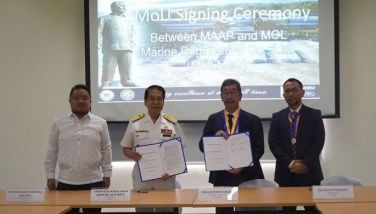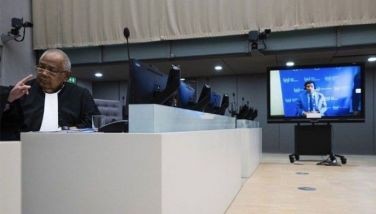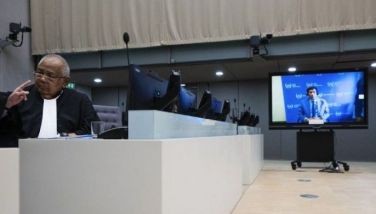Toying with the lives of MRT passengers

DREADFUL SCENARIO: The Aquino administration is taking a big gamble playing with the lives of some 550,000 passengers packed each day on the trains of the Metro Rail Transit Line-3 (MRT-3) running in the middle of EDSA.
The Department of Transportation and Communication seems unperturbed by the possibility that one of the few running MRT trains may just jump off the badly damaged rails and fall into the street below, bringing with it its overload of passengers.
This dreadful scenario is hinted at in the latest audit report on the system conducted by the Mass Transit Railway of Hong Kong (MTR HK). Their report, presented to Congress last Monday, says MRT-3 is not safe and needs immediate attention.
The audit included inspection of tracks (rails), rolling stock (trains), signaling system, high-voltage power supply system, communication system, the stations and their facilities, and the depot.
* * *
DAMAGED RAILS: Of the items audited, the tracks were reported to be in the most alarming condition. They were rated “poor,” the lowest of five grades used by MTR HK (the higher grades being good, satisfactory, fair and unsatisfactory).
“Poor” is defined to mean “major or extensive defect exists” and that “customer requirements are consistently not being met.”
MTR HK said: “The track is in a poor and unacceptable condition to allow continuous safe operation up to its designed standard. Starting from Aug. 20, 2014, the running speed was restricted to 40 kph from 65 kph to reduce the safety risk posed to passengers. While it may reduce the chance of rail break in the short term, it does not obviate the need to put forward an immediate plan to correct the situation.”
It said that MRT-3 operations should be stopped for the safety of passengers until the tracks are replaced properly.
* * *
QUICK FIX: What is the danger of having just a temporarily fix with fish plate clamp as undertaken by the DoTC?
• First scenario is that the trains will run at a much SLOWER SPEED as they traverse the fish plate clamp. From the already slower 40 kph, trains will have to run at only 10-15 kph as they pass the clamps. If the MRT were maintained properly, the trains would be running at 65 kph.
• Second scenario is a STOPPAGE of the trains. If glitches crop up in the signaling system, operations would have to be stopped since there are fish plate clamps and any breakdowns in the tracks with the broken or damaged rails would be undetected.
• Worst-case scenario is DERAILMENT, with a train falling off the tracks. This could happen if no necessary steps are taken to buy spare parts and maintain the trains properly.
The correct immediate solution is obvious: Replace the rails. Hammering them back into shape or putting a clamp on them will not work.
* * *
SPARE PARTS: Transportation Secretary Joseph Emilio Abaya has not explained satisfactorily why APT Global, which holds the current maintenance provider contract, is not buying any new stock rails.
While the former maintenance provider Sumitomo Corp. left 122 stock rails, the latest news reports say that APT Global now has only one stock rail left!
Is not APT Global supposed to buy stock rails with its P57-million monthly budget? This amount is for services AND spare parts. So why is it not buying needed parts?
During its 12-year service, Sumitomo spent 60 percent of its budget procuring parts under an agreed concept of a Single Point of Responsibility. As overall maintenance provider, it was responsible for any damage or incident, so it made sure it had the spare parts ready.
Why is Abaya afraid to demand from APT Global the same responsibility?
* * *
DOTC PLAN: The riding public cannot wait for the DoTC, which seems to be sitting on its hands waiting for a major accident to happen before it moves in a big way.
It proposes an Equity Value Buy-Out (EVBO), the importation of 48 Chinese coaches (the prototype to arrive in 2015), and the bidding out of a new maintenance provider contract.
But the EVBO may not work, because (1) The money for it has been taken out of the budget, and (2) It would not rehabilitate the system but only pay off Land Bank and Development Bank of the Philippines, just moving P54 billion from one government pocket to another.
Experts have questioned the wisdom of buying 48 imitation coaches from China, because (1) the Chinese supplier, Dalian Locomotives, specializes in locomotives, not double articulated light rail vehicles, and (2) the imported trains will only augment, not rehabilitate, the existing 73-car fleet.
* * *
COUNTER-PLAN: Submitting to Congress last Monday a proposal for faster rehabilitation, MRT Holdings Chairman Robert John Sobrepeña called for hiring a maintenance provider that will take on not only repairs but the general overhaul of all existing 73 cars within 18 months.
On top of the immediate overhaul, his proposal includes the maintenance of the existing MRT-3 Phase 1 as well as labor, the purchase of spare parts, and another general overhauling in 2024.
The operation and maintenance of the MRT-3 system would then go to the private sector instead of to government under a management agreement with the DoTC.
The private owners offer to invest $98 million or P4.5 billion, plus a $ 2.2-million fixed monthly cost for 10 years under a Built-Lease-Transfer (BLT) agreement. There will be revenue-sharing with the DoTC and a restructuring of the MRT bonds to take out government subsidy.
Sobrepeña said this contract will allow the return of a Single Point of Responsibility by the chosen maintenance provider, preferably Sumitomo Corp., which designed, built and maintained the MRT-3 system for 12 years.
He assuaged fears of higher MRT fares, saying that they will not be higher than bus rates on EDSA.
* * *
RESEARCH: Access past POSTSCRIPTs at www.manilamail.com. Follow us via Twitter.com/@FDPascual. Email feedback to dikpascual@gmail.com
- Latest
- Trending



























